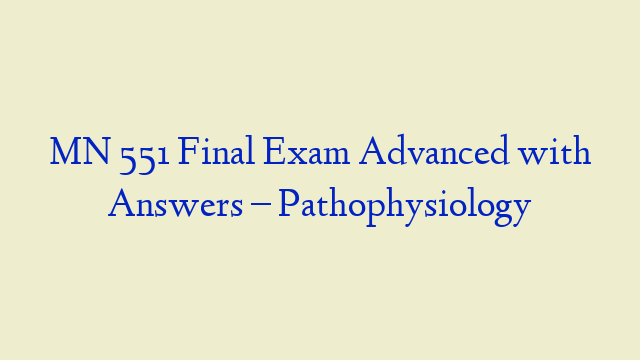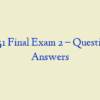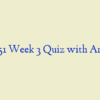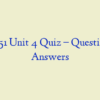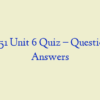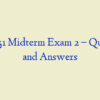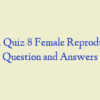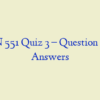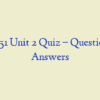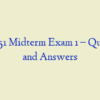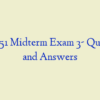Description
MN 551 Final Exam Advanced Pathophysiology
- A female neonate has been in respiratory distress since delivery and is unresponsive to oxygen therapy. Endoscopy has confirmed a diagnosis of esophageal atresia and tracheoesophageal fistula (EA/TEF). Which of the following explanations should the care team provide to the infant’s parents?
- The father of an 18-month-old girl noticed a small vesicle on her face several days ago. The lesion ruptured and left a straw-colored crust that remained on the girl’s face. The eruption of new vesicles has prompted him to bring the child to the emergency department. Which of the following treatments for the child’s skin problem is most likely?
- Following a long history of fatigue, weakness, and poor appetite, a 39-year-old male has been diagnosed with hypopituitarism. Which of the following clinical findings would most likely cause his care team to suspect that the man has an additional endocrine disorder from a different source?
- A 46-year-old male has presented to the emergency department because of the eye pain, severe headache, and blurred vision that have followed an eye exam at an optometrist’s office earlier in the day. The patient tells the triage nurse that he received eyedrops during the exam “to keep my pupils wide open.” What differential diagnosis will the care team first suspect?
- A nurse practitioner is providing care for a 40-year-old male who is experiencing chronic insomnia in recent months while going through a divorce and child custody proceedings. The man is requesting a prescription for “sleeping pills” to help him through this time. Which of the following statements forms a valid basis for the nurse practitioner’s plan for treatment?
- A 24-year-old woman undergoing a premarital screening test is found to have elevated levels of AST, ALT, and IgG, but no antibody-specific markers for viral hepatitis. A liver biopsy reveals inflammation and cellular damage. Which of the following treatments is most likely to be effective for her?
- A 51-year-old woman who has been receiving estrogen and progesterone therapy (EPT) for the last 5 years has visited her care provider because her peers have told her about the risks of heart disease, stroke, and breast cancer that could accompany hormone therapy (HT). How should her care provider respond to her concerns?
- Having heard positive reports of the benefits of HT from her sister-in-law and friends, a 49-year-old woman has presented to her nurse practitioner asking to start HT. Her uterus is intact and previous bone scans have indicated low bone density. The patient also has a family history of heart disease. She characterizes her symptoms of menopause as “noticeable, but not debilitating by any means.” Based on the most current research, what is her nurse practitioner’s best course of action?
- A 51-year-old woman has been experiencing signs and symptoms of perimenopause and has sought help from her nurse practitioner. Doctors have confirmed a deficiency in estrogen levels as a contributing factor. Which of the following phenomena could potentially underlie the woman’s health problem?
- A 17-year-old female is suspected of having narcolepsy. Which of the following aspects of her medical history and sleep analysis would contribute to a confirmation of the diagnosis?
- The unique clinical presentation of a three-month-old infant in the emergency department leads the care team to suspect botulism. Which of the following assessment questions posed to the parents is likely to be most useful in the differential diagnosis?
- A 32-year-old man is complaining of burning, itching, photophobia, and severe pain in his right eye after swimming in the ocean. To determine that the eye condition is corneal rather than a conjunctival disease, which of the following would be the distinguishing symptom?
- A 20-year-old male has been diagnosed with a chlamydial infection, and his primary care provider is performing teaching in an effort to prevent the patient from infecting others in the future. Which of the following statements by the patient demonstrates the best understanding of his health problem?
- A newborn male has been diagnosed with hypospadias following his postpartum assessment by a nurse practitioner. Which of the following diagnostics and treatment options is the nurse practitioner most likely to rule out first?
- A 66-year-old man has presented to a nurse practitioner to get a refill for his antiplatelet medication. The patient has a history of ischemic heart disease and suffered a myocardial infarction 5 years ago and has unstable angina; he uses a transdermal nitroglycerin patch to control his angina. The patient has a 40-pack-year smoking history and uses nebulized bronchodilators at home for the treatment of transient shortness of breath. He has long-standing hypertension that is treated with a potassium-sparing diuretic and a ß-adrenergic blocking medication. During the nurse’s assessment, the man notes that he has been unable to maintain his erection in recent months. Which of the following aspects of the man’s health problems and treatments would the nurse identify as NOT being contributing to his erectile dysfunction (ED)?
- A 30-year-old woman has sought care because of her recurrent photophobia, tearing, and eye irritation. During assessment, her care provider asks about any history of cold sores or genital herpes. What is the rationale for the care provider’s line of questioning?
- A 57-year-old woman who has been diagnosed with atrophic vaginitis has expressed her surprise to her care provider, citing a lifetime largely free of gynecological health problems. She has asked what may have contributed to her problem. How can the care provider best respond?
- After a long and frustrating course of constant vaginal pain, a 38-year-old woman has been diagnosed with generalized vulvodynia by her nurse practitioner. What treatment plan is her nurse practitioner most likely to propose?
- Which of the following statements best conveys an aspect of the process of keratinization?
- A woman with severe visual and auditory deficits is able to identify individuals by running her fingers lightly over their face. Which of the following sources is most likely to provide the input that allows for the woman’s ability?
- The parents of a 15-year-old boy are frustrated by his persistent inability to fall asleep at a reasonable hour at night, as well as the extreme difficulty that they have in rousing him in the morning. While sleepy after waking, the son claims not to feel drowsy after lunch or in the evening. What is the most likely classification of the boy’s sleep disorder?
- Laparoscopic knee surgery on a 22-year-old basketball player has necessitated entry into the synovial cavity. The surgeon performing the procedure would be aware of which of the following relevant characteristics of synovial tissue?
- A 22-year-old female college student is shocked to receive a diagnosis of myasthenia gravis. What are the etiology and most likely treatment for her health problem?
- Which of the following conditions usually improves when a woman is taking oral contraceptives?
- Which of the following diagnostic findings would be a clinician’s priority for further investigation and possible medical intervention?
- A pregnant 23-year-old with a diagnosis of herpes simplex virus (HSV) is receiving prenatal care from her nurse practitioner. What is the nurse practitioner most likely to tell the patient about the precautions that will be taken to prevent transmission of the virus to her baby?
- A 51-year-old has been admitted to a rehabilitation center after hospital treatment for an ischemic stroke. Which of the following aspects of the patient’s history would not be considered to have contributed to his stroke?
- An 18-year-old female of Southeast Asian ancestry is distraught over the recent appearance of white patches on her forearms and upper arms, which subsequently have been confirmed to be vitiligo. Which of the following statements by the woman expresses an accurate understanding of her condition?
- During descent, an airplane passenger is complaining that his “ears are plugged.” What aspect of the structure and function of the ear best accounts for the passenger’s complaint?
- Which of the following recent admissions to an emergency department is most likely to be diagnosed with a greenstick fracture?
- Epididymitis
- John presents to the clinic with complaints of scrotal heaviness. Your assessment reveals swelling of the testicle and warm scrotal skin. What would your diagnosis be?
- A 29-year-old woman has been diagnosed with otosclerosis after several years of progressive hearing loss. What pathophysiologic process has characterized her diagnosis?
- A 29-year-old woman has been trying for many months to become pregnant, and fertilization has just occurred following her most recent ovulation. What process will now occur that will differentiate this ovulatory cycle from those prior?
- A female patient is suspected of having psoriasis. Which of the following aspects of the woman’s history and her care provider’s assessment would be potential contributors to her health problem?
- A 17-year-old male experienced third-degree, full-thickness burns to his lower limbs after a fire at his workplace 2 days ago. Which of the following complications should his care team NOT foresee and regularly assess for?
- An 80-year-old female with a diagnosis of osteoporosis receives daily supplements of calcitonin in the form of a nasal spray that she instills each morning. Which of the following phenomena would her care providers expect to result from her supplementation?
- Which of the following questions is most likely to be clinically useful in the differential diagnosis of sensorineural versus conductive hearing loss?
- A 48-year-old male has a new diagnosis of Guillain-Barré syndrome. Which of the following processes underlies the deficits that accompany the degeneration of myelin in his peripheral nervous system (PNS)?
- A 40-year-old woman has been found to have a deficiency in estrogen. Which of the following physiological phenomena is most likely to remain unaffected?
- Which of the following statements best captures an aspect of normal spermatogenesis?
- A nurse practitioner and social worker are facilitating a family meeting for the children and wife of a 79-year-old man who has been diagnosed with Alzheimer disease. What goal of treatment will the clinicians most likely prioritize in their interactions with the family?
- A patient on an acute medicine unit of a hospital, with a diagnosis of small bowel obstruction, is complaining of intense, diffuse pain in her abdomen. Which of the following physiologic phenomena is most likely contributing to her complaint?
- A 29-year-old female has been admitted to the emergency department following a suicide attempt by overdose of acetaminophen. What changes in the patient’s liver and diagnostic results would the care team most likely anticipate?
- A nurse practitioner is assessing a 7-year-old boy who has been brought to the clinic by his mother, who is concerned about her son’s increasingly frequent, severe headaches. Which of the nurse’s following questions is least likely to yield data that will allow for a confirmation or ruling out of migraines as the cause of his problem?
